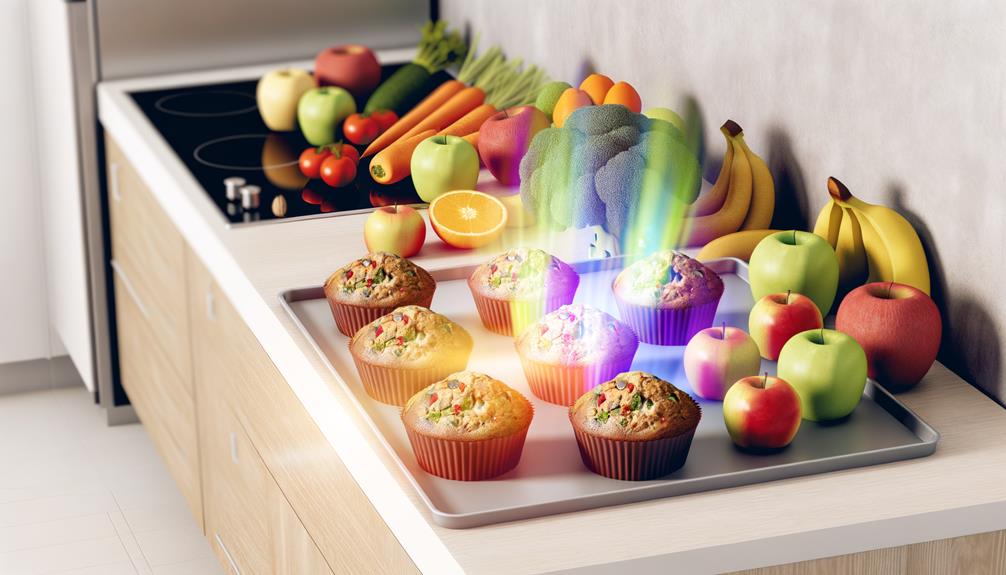You’re about to embark on a culinary journey as vast as the spice markets of Marrakesh, filled with exotic flavors, fragrant aromas, and health-conscious choices. Vegan baking, especially low-fat vegan baking, is an art form that’s as rewarding as it is challenging, but don’t fret, it’s not as intimidating as it sounds. With these 11 essential tips, you’ll soon be whipping up low-fat vegan treats that not only taste divine but also align with your dietary preferences. From swapping out traditional baking staples with nutrient-packed alternatives to enhancing your bakes with aromatic spices, you’re about to discover a whole new world of vegan baking. But where, you might ask, does one start on this exciting journey? Well, that’s a secret we’re about to unfold.
Key Takeaways
- Seek out adaptable recipes that don’t rely heavily on eggs or butter and experiment with vegan butter as a substitute for regular butter.
- Embrace the unique flavors of plant-based ingredients like coconut, cashews, tahini, coconut sugar, maple, and banana to update old favorites with plant-based twists and creativity.
- Replace eggs in vegan baking with mashed bananas or applesauce as binders, vinegar and baking soda for leavening agents, non-dairy milk or coconut oil for creaminess, ground flaxseed mixed with water for a viscous consistency, or whipped aquafaba as a substitute for egg whites.
- Choose low-fat alternatives by replacing traditional fats with nuts, seeds, and nut butters, using plant-based oils like canola, coconut, or olive oil instead of vegetable shortening, switching granulated sugar with natural sweeteners like coconut sugar, maple syrup, or agave syrup, and incorporating low-fat alternatives like plant-based yogurt, vegetable purees, and almond milk for unique flavors and textures.
Selecting the Right Recipe
When you’re on the hunt for the perfect low-fat vegan baking recipe, start by seeking out those that are adaptable to substitutions and don’t hinge on the heavy use of eggs or butter. Vegan baking is a delightful and health-conscious journey, where the right recipe can make a world of difference.
Remember, your plant-based diet doesn’t mean you must sacrifice richness or texture. Indeed, oats, nuts, seeds, and other textured add-ins can be your secret weapons in creating vegan desserts that are both hearty and delicious. Embrace the unique flavors of plant-based ingredients like coconut, cashews, tahini, coconut sugar, maple, and banana. They can add warmth, sweetness, and complexity to your vegan recipes.
As you’re selecting the right recipe, don’t be afraid to experiment. The traditional baking rules do not always apply in vegan baking. You can update old favorites with a dash of creativity and a pinch of plant-based twists. Besides, vegan butter is a fantastic substitute for regular butter, and it maintains the luscious mouthfeel of your beloved baked goods.
Ultimately, your low-fat vegan baking journey is about serving others with love, health, and a spoonful of deliciousness.
Embracing Unusual Ingredients
In the realm of low-fat vegan baking, don’t shy away from unusual ingredients like tahini, coconut sugar, or textured add-ins, as they can infuse your recipes with unique flavors and textures. These ingredients can help replace traditional butter substitutes and egg replacers, making your dishes both healthier and more flavorful.
- Tahini: Instead of using butter substitutes, try tahini. This sesame seed paste adds a rich, nutty flavor to your baking and is a healthier, low-fat option.
- Coconut Sugar: When it comes to sweetening your treats, replace refined sugars with coconut sugar. It has a lower glycemic index and a distinct, caramel-like flavor.
- Textured Add-ins: Ingredients like oats, nuts, and seeds can add a surprising crunch to your baked goods. These add-ins also increase the nutritional value of your treats.
Embracing unusual ingredients in vegan baking not only allows you to experiment with flavors but also helps in creating healthy, low-fat options. So, next time you’re baking, remember to replace dairy milk with coconut milk and embrace the adventure of using new, exciting ingredients. Serving others has never tasted so good.
Replacing Eggs in Vegan Baking
Just as you’ve ventured into using unconventional ingredients, let’s now tackle the challenge of replacing eggs in your vegan baking endeavors. To understand how egg replacement works, consider the role the egg plays in recipes that call for it. Is it for binding, leavening, or maybe for flavor and texture?
Vegan egg substitutes abound, each serving different purposes. Need a binder? Mashed bananas or applesauce work wonders. If the recipe calls for a leavening agent, a mix of vinegar and baking soda will do the trick. For recipes that call for butter, replace butter with non-dairy milk or coconut oil, keeping the same creamy texture and richness.
Ground flaxseed mixed with water can create a viscous consistency similar to an egg, while silken tofu provides a smooth, creamy texture. Aquafaba, the liquid from canned chickpeas, can even be whipped like egg whites!
Choosing Low-Fat Alternatives
Navigating the world of low-fat alternatives can be a joy, allowing you to experiment with nutritious and delicious options like plant-based yogurt, vegetable purees, and almond milk in your vegan baking. These alternatives not only give your baked goods a unique flavor and texture, but also make them healthier.
Here are some low-fat alternatives you can consider:
- Replace traditional fats with healthier sources such as nuts, seeds, and nut butters. They add richness to your recipes without the extra fat.
- Use plant-based oils instead of vegetable shortening. Canola, coconut, or olive oil are excellent choices. Just remember, they have different melting points that can affect your baking.
- Switch out granulated sugar for natural sweeteners like coconut sugar, maple syrup, or agave syrup. They’ll still sweeten your treats but with less fat.
Incorporating these changes in your vegan baking doesn’t mean sacrificing flavor. In fact, it’s an opportunity to explore a diverse range of ingredients that can enhance your baked goods in new and exciting ways. So, go ahead, delight your guests with healthier, tastier treats. They’ll appreciate your commitment to serving delicious and low-fat alternatives.
Sweetening Your Vegan Bakes
While embracing healthier fats in your vegan baking, don’t forget the sweet side of things; there’s a whole world of natural, low-fat sweeteners waiting to be explored. Organic cane sugar is a classic choice, but you can also experiment with coconut sugar or liquid sweeteners like maple or agave syrup for a unique flavor profile.
Take a traditional approach by using ripe, mashed sweet potato to add a subtly sweet note to your vegan baked goods. Mashed bananas or applesauce also work wonders as natural, low-fat vegan baking sweeteners. These fruit purees not only sweeten your bakes but also add moisture, eliminating the need for additional fats.
Ever thought of using date paste or syrup? It’s a whole food sweetener that can do wonders for your vegan baked treats. Pureed fruits, such as berries or mangoes, can also be incorporated for natural sweetness.
Experimentation in Vegan Baking
In your quest for healthier baking, don’t shy away from experimenting with the unique flavors of plant-based ingredients like coconut, cashews, tahini, and more. This is the essence of experimentation in vegan baking. It’s not just about making vegan versions of traditional recipes, but also exploring the vast possibilities that plant-based ingredients offer.
Here are 3 tips and tricks to make your experimentation successful:
- Understand your ingredients: Not all fats are created equal. Coconut, canola, and olive oils each have different melting points and effects on baked goods. Understand these nuances to create delicious low-fat vegan baking recipes.
- Play with flavors: Don’t limit yourself to traditional combinations. Be adventurous! Who said a cashew-tahini brownie wouldn’t be heavenly?
- Learn from failures: Not every experiment will be a success, but each will teach you something. Embrace this as part of the process.
Stocking Your Vegan Pantry
Having embraced the art of experimenting with flavors in vegan baking, it’s crucial that your pantry is always stocked with essential plant-based ingredients. A well-stocked pantry is your secret weapon for whipping up scrumptious vegan masterpieces like chocolate chip cookies or peanut butter treats.
Let’s visualize your pantry with a simple table:
| Staple Ingredients | Substitutes |
|---|---|
| Butter | Coconut oil, vegan butter |
| Eggs | Flaxseed, aquafaba, silken tofu |
| Milk | Almond milk, oat milk, soy milk |
| Baking staples | Oats, nuts, seeds, cashews, tahini, coconut |
| Sweeteners | Maple syrup, agave nectar |
Remember, the goal is to have 78 different items stocked in your pantry to cater to all your baking needs. Don’t shy away from plant-based substitutes like coconut oil for butter, or almond milk for regular milk. They add a unique flavor profile and keep your baked goods low-fat and health-conscious.
Now, you’re ready to serve up mouth-watering vegan baked goods, infused with traditional spices and packed with nutrition. Happy vegan baking!
Replacing Milk in Vegan Baking
To whip up your favorite baked treats without a drop of dairy, you can turn to plant milks like almond, soy, coconut, rice, or oat milk, which promise an exciting flavor twist and a healthy twist to your traditional recipes. Replacing milk in vegan baking is not just about dodging dairy, it’s about adding a new depth of flavor to your baked goods.
When a recipe calls for milk, you’ve got options:
- Almond milk can be used for a nutty twist.
- Coconut milk adds a tropical hint.
- Soy milk provides a creamy, neutral base.
Each milk alternative has a different fat content, so you’ll need to experiment a bit to find what works best for your low-fat vegan baking. Remember, solid fats like vegan margarine can also help to create rich, moist baked goods.
In the spirit of serving others, make sure to consider allergies and dietary restrictions when choosing which milk to use. Whether it’s cow’s milk or almond milk, every choice you make can help to create a delicious, health-conscious treat that everyone can enjoy.
Swapping Butter in Vegan Baking
Just as you’ve mastered the art of replacing dairy milk with plant alternatives, let’s tackle another baking staple: butter. Swapping butter in vegan baking can be a challenge, but with a few tips, it’ll be a piece of (vegan) cake!
Consider using plant-based oils like canola, coconut, and olive as your go-to substitutes. They’re a favorite vegan alternative, made with coconut oil being especially great for pastries. But remember, different oils have varying melting points, affecting how your cookies might spread during baking.
Keep a table like this handy:
| Ingredient | Use | Works Best In |
|---|---|---|
| Canola Oil | General Baking | Cakes, Brownies |
| Coconut Oil | Pastry, High-Heat Baking | Pie Crusts, Scones |
| Olive Oil | Savory Baking | Bread, Pizza Dough |
| Vegan Butter | Special Occasions | When Butter Flavor is Key |
| Mashed Banana/Seed Butters | Reduce Fat Content | Muffins, Quick Breads |
Experiment with nut or seed butters and mashed banana as a low-fat vegan baking substitute for some or all of the oil in a recipe. These work well in muffins and quick breads. Happy baking!
Oil-free Vegan Baking Techniques
Delving into oil-free vegan baking techniques, you’ll find that it’s a creative exploration of plant-based egg replacers, dairy substitutes, and low-fat sweeteners, all contributing to delectably healthy treats.
- Your favorite egg substitute could be a tablespoon of ground flaxseed mixed with three tablespoons of water, a great vegan egg choice brimming with omega-3 fatty acids.
- Another method is using vinegar to replace eggs, which works particularly well in cakes and cupcakes.
- Pureed fruits and vegetables like applesauce, bananas, or even pumpkin can also replace both eggs and oil, offering moistness and flavor.
With these tips, you’ll be able to create mouth-watering, oil-free vegan baked goods that are not only healthier but also cruelty-free. Experiment with various dairy substitutes like almond or soy milk and opt for low-fat sweeteners such as maple syrup or organic cane sugar.
Importance of Nut-free Desserts
In the realm of health-conscious baking, it’s crucial that you consider the importance of nut-free desserts, not just for those with allergies, but also to foster creativity and inclusivity in your culinary repertoire. Understanding the necessity of these desserts is a rule of thumb for every considerate baker.
Creating nut-free desserts isn’t difficult. A simple swap for nutty ingredients can be seeds, oats, or even coconut. For instance, in quick breads, a teaspoon of baking soda, combined with a tablespoon of white vinegar, works great as a rising agent. To replace the moistness of nuts, a few extra tablespoons of water can be added to your batter.
The importance of nut-free desserts extends beyond just catering to allergies. They also work to make your baking more accessible, inviting a wider audience to enjoy your creations. Plus, they inspire you to experiment with new, diverse ingredients.
Frequently Asked Questions
What Is a Vegan Fat Substitute for Baking?
Ever thought about avocado’s benefits in baking? You can use it, coconut cream, nut butters, flaxseed oil, silken tofu, pureed fruits, even cacao nibs! They’re healthy, flavorful, and perfect for your vegan baking needs.
What Is the Best Fat for Vegan Baking?
You’re exploring best fats for vegan baking? Coconut oil boasts health benefits, avocado adds creaminess, nut and seed butters offer richness, and cacao butter provides decadence. Balance taste, health implications, and sustainability in your choices.
What Can I Use Instead of Butter for Vegan Baking?
You can swap butter for plant-based oils like avocado or olive oil. Nut spreads, coconut cream, seed butters, or fruit purees are great alternatives. Even plant-based yogurt can be used in your vegan baking.
Why Use Vinegar in Vegan Baking?
You’re using vinegar in vegan baking as it’s like a secret weapon. Vinegar’s role encompasses initiating acidic reactions for baking science, enhancing flavor, improving texture, acting as a chemical substitute, and offering vinegar variety choices.







